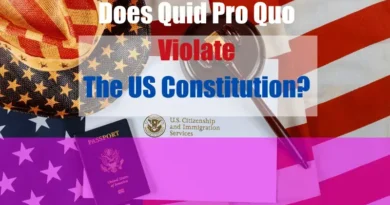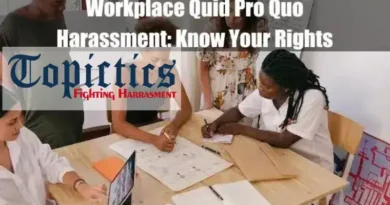Explaining Sexual Favors Considering Harassment
Takeaways
| Key Points |
|---|
| Sexual favors in the context of harassment refer to unwelcome requests for sexual activities tied to professional benefits or avoiding negative consequences, often arising in environments with power imbalances. |
| Legally, sexual favors fall under sexual harassment, as defined by the Equal Employment Opportunity Commission (EEOC), encompassing unwelcome advances, demands, or conduct that affect employment, create a hostile work environment, or hinder work performance. |
| Key legislation like Title VII of the Civil Rights Act of 1964 prohibits such harassment, with notable cases such as Williams v. Saxbe and Meritor Savings Bank v. Vinson setting legal precedents for recognizing quid pro quo harassment and employer liability. |
| Common scenarios include supervisors leveraging their authority to coerce subordinates into sexual activities, often disguising coercion as consensual interactions, though the presence of threats or promises invalidates consent. |
| Addressing sexual favors requires awareness of the dynamics of power, the distinction between coercion and true consent, and robust anti-harassment policies to protect individuals and enforce accountability. |
Introduction to Sexual Favors
Definition and Context of Sexual Favors
Sexual favors in the context of harassment refer to unwelcome requests or demands for sexual activities made by someone in a position of power. These requests are often tied to employment benefits or avoiding negative consequences.
Sexual favors can include any sexual activity or conduct that is solicited as a condition of employment, promotion, or other professional advantages. The issue is prevalent in various sectors, leading to significant personal and professional ramifications for victims.
Legal Definitions and Framework
Understanding Sexual Favors in Legal Terms
Sexual favors, as legally defined, fall under the broader category of sexual harassment. According to the Equal Employment Opportunity Commission (EEOC), sexual harassment includes unwelcome sexual advances, requests for sexual favors, and other verbal or physical conduct of a sexual nature.
These actions become illegal when they explicitly or implicitly affect an individual’s employment, unreasonably interfere with their work performance, or create a hostile work environment.

Key Legislation Addressing Sexual Favors as Harassment
Title VII of the Civil Rights Act of 1964 is the cornerstone legislation addressing sexual harassment in the workplace. It prohibits employment discrimination based on race, color, religion, sex, and national origin.
The EEOC enforces this law, providing guidelines and processes for victims to report harassment and seek redress. Other significant legislations include Title IX of the Education Amendments of 1972, which addresses sexual harassment in educational institutions, and various state laws that provide additional protections and remedies for victims.
Case Law and Legal Precedents
1. Williams v. Saxbe (1976):
This case indeed established a critical precedent in recognizing quid pro quo sexual harassment as sex discrimination under Title VII. The U.S. District Court for the District of Columbia ruled that the discharge of Diane R. Williams for rejecting her male supervisor’s sexual advances constituted sex discrimination.
2. Meritor Savings Bank v. Vinson (1986):
The Supreme Court held that a claim of a hostile work environment could be established if the conduct was severe or pervasive enough to create an abusive working environment, even without economic loss. This case involved allegations that the plaintiff’s supervisor repeatedly demanded sexual favors, which she complied with out of fear for her job.
3. Burlington Industries, Inc. v. Ellerth (1998):
This Supreme Court case clarified employer liability for quid pro quo harassment. Kimberly Ellerth claimed that her supervisor made unwelcome sexual advances and implied that her job benefits were contingent on compliance. The Court held that employers could be liable for supervisors’ actions that create a hostile work environment, emphasizing the necessity of anti-harassment policies and complaint procedures.
4. Faragher v. City of Boca Raton (1998):
This case decided alongside Ellerth, addressed employer liability for sexual harassment by supervisors. The Supreme Court ruled that employers are liable for actionable discrimination caused by supervisors with immediate authority over employees, reinforcing the need for preventative measures and response mechanisms to harassment claims.
These cases are significant in shaping the legal framework for addressing and adjudicating quid pro quo sexual harassment claims in the workplace. They provide a robust foundation for understanding the legal responsibilities of employers and the protections afforded to employees under Title VII of the Civil Rights Act.
Mechanisms of Sexual Favors in Harassment
Dynamics of Coercion and Power Imbalances
Sexual favors are often demanded in environments where there is a significant power imbalance. Supervisors or individuals in authoritative positions may exploit their power to coerce subordinates into unwanted sexual activities.
This dynamic creates an atmosphere of fear and intimidation, where victims may comply with such demands to avoid retaliation or negative professional consequences.
Typical Scenarios and Examples of Sexual Favors Demanded
Common scenarios include supervisors asking for sexual favors in exchange for promotions, job security, or favorable work assignments. These requests can be direct or subtle, often disguised as consensual interactions but inherently coercive due to the power dynamics involved.
Examples include a boss suggesting a quid pro quo arrangement during performance reviews or a manager implying that an employee’s job security depends on their willingness to engage in sexual activities.
Differences Between Consensual Acts and Coercion
The key distinction between consensual acts and coercion lies in the element of choice. Consensual acts are based on mutual agreement and free will, without undue pressure or threats. In contrast, coercion involves using power or authority to compel someone into sexual activities against their will.
The presence of threats, implied consequences, or promises of professional benefits invalidates any notion of true consent.

Impact on Victims
Psychological and Emotional Consequences
Victims of sexual favor harassment often experience profound psychological distress. The continuous pressure and fear of retaliation can lead to anxiety, depression, and a sense of powerlessness.
The trauma associated with such harassment can have lasting effects, impacting the victim’s mental health and overall well-being.
Professional and Personal Repercussions
Professionally, victims may suffer from reduced job performance, missed promotions, and damaged reputations. The stress and anxiety associated with harassment can lead to decreased productivity and job satisfaction.
Personally, the harassment can strain relationships, erode self-esteem, and lead to social withdrawal. The combined professional and personal impacts underscore the severe consequences of sexual favor harassment.
Reporting and Addressing Sexual Favor Harassment
Steps for Victims to Report Incidents
Victims should meticulously document every incident, noting dates, times, locations, and any witnesses. This documentation can be crucial in investigations. The next step is to report the harassment to a supervisor, human resources department, or designated workplace harassment officer. If internal reporting does not resolve the issue, victims can also file complaints with external bodies like the EEOC.
Internal and External Reporting Mechanisms
Internally, organizations should have clear policies and procedures for reporting harassment. This includes multiple reporting channels to accommodate different comfort levels.
Externally, the EEOC provides a platform for victims to file formal complaints. State and local agencies also offer additional avenues for reporting and seeking justice.

Ensuring Confidentiality and Protection Against Retaliation
Maintaining confidentiality is crucial to protect victims from further harm. Organizations must ensure that reports are handled discreetly, sharing information only with those involved in the investigation.
Protection against retaliation is equally important, as fear of reprisal can deter victims from coming forward. Legal provisions, such as those enforced by the EEOC, prohibit any adverse actions against individuals who report harassment or participate in investigations.
Organizational Responsibilities and Best Practices
Developing Clear Policies on Sexual Favors and Harassment
Organizations must establish explicit policies addressing sexual favors and harassment. These policies should clearly define unacceptable behaviors, outline reporting procedures, and specify the consequences of violations.
By setting clear expectations, organizations communicate their commitment to a harassment-free workplace.
Regularly reviewing and updating these policies is essential to ensure they remain relevant and effective in addressing evolving workplace dynamics and legal standards.
Training and Awareness Programs Focused on Sexual Favors
Regular training sessions are vital for educating employees about the nature of sexual favors and harassment. These programs should cover recognizing harassment, understanding the impact on victims, and knowing how to report incidents.
Training should be mandatory for all employees, including management, to foster a culture of awareness and prevention. Real-life scenarios and role-playing can enhance understanding and engagement during these sessions.
Creating a Safe and Supportive Work Environment
A supportive environment encourages employees to speak up without fear of retaliation. Establishing multiple reporting channels, such as anonymous hotlines and online platforms, can accommodate different comfort levels.
Organizations should ensure that all reports are taken seriously, investigated promptly, and handled confidentially. Providing resources like counseling services and legal assistance can support victims and mitigate the psychological impact of harassment.
Legal Recourse and Support Systems
Organizations must comply with federal, state, and local laws regarding harassment prevention. This includes regular audits and assessments to identify non-compliance areas and take corrective actions. Providing training on employees’ rights and responsibilities under these laws helps maintain a lawful and respectful workplace.
Legal aid and advocacy organizations can offer additional support to victims, ensuring they have access to justice and protection from further harm.

Overview of Legal Options for Victims
Role of Legal Aid and Advocacy Organizations
Legal aid organizations and advocacy groups play a crucial role in supporting victims of sexual favor harassment. They offer legal advice, representation, and resources to help victims navigate the complexities of filing complaints and pursuing legal action.
These organizations also advocate for policy changes and improved employee protections, contributing to broader efforts to combat workplace harassment.
Examples of Successful Legal Interventions
Successful legal interventions often result in significant changes within organizations. For instance, cases where victims have received compensatory damages and policy reforms demonstrate the effectiveness of legal action.
These cases provide justice to the victims and set precedents that deter future harassment and encourage other victims to come forward. Examples include cases where courts have mandated comprehensive training programs and stricter enforcement of harassment policies.
Preventative Strategies
Best Practices for Preventing Demands for Sexual Favors
Preventative strategies should focus on creating a culture of respect and zero tolerance for harassment. This includes promoting diversity and inclusion, addressing power imbalances, and ensuring that all employees understand the consequences of harassment.
Clear policies and consistent enforcement strongly convey that harassment will not be tolerated.
Regular Training and Education Programs
Regular training and education programs are essential for reinforcing the importance of a harassment-free workplace. These programs should be interactive and updated regularly to reflect current legal standards and workplace dynamics.
Training should cover recognizing harassment, reporting procedures, and the organization’s commitment to addressing all complaints promptly and fairly.
Encouraging a Culture of Respect and Zero Tolerance
Encouraging open communication and transparency helps build a positive workplace culture. Employers should create safe spaces for employees to voice concerns and provide feedback without fear of retaliation. Promoting diversity and inclusion initiatives, such as employee resource groups and diversity councils, can also contribute to a respectful and equitable work environment.
Case Studies and Real-World Examples
Detailed Analysis of Prominent Cases Involving Sexual Favors
Analyzing prominent cases of sexual favor harassment provides valuable insights into the dynamics of such incidents and the effectiveness of different interventions. For example, the case of Meritor Savings Bank v. Vinson highlighted the importance of recognizing hostile work environments and setting significant legal precedents for future cases.
Lessons Learned and Best Practices Identified
These case studies reveal critical lessons about the importance of clear policies, prompt reporting and investigation, and strong organizational commitment to addressing harassment. They demonstrate the need for ongoing education, support systems for victims, and consistent enforcement of anti-harassment measures.
Application of Legal and Organizational Responses
Effective responses to harassment include legal actions that provide justice for victims and organizational reforms that prevent future incidents. Successful interventions often involve comprehensive policy reviews, enhanced training programs, and the establishment of robust reporting and support systems.
These measures ensure that organizations comply with legal standards and foster a safe and respectful work environment.
Conclusion
Addressing sexual favors in the context of harassment requires a multifaceted approach involving clear policies, regular training, supportive environments, and strong legal and organizational responses.
By learning from past cases and continuously improving preventative measures, organizations can create workplaces where all employees feel valued and respected.
Committing to a harassment-free workplace is not only a legal obligation but also a moral imperative that underpins the integrity and productivity of any organization.
FAQ
What is Quid Pro Quo Sexual Harassment?
Quid pro quo sexual harassment occurs when someone in a position of authority explicitly or implicitly demands sexual favors in exchange for employment benefits, promotions, or other advantages. It creates a clear conditional relationship where compliance is rewarded, and refusal is met with adverse consequences.
What is a Hostile Work Environment for Sexual Harassment?
Hostile work environment sexual harassment refers to unwelcome sexual behavior or conduct that creates an intimidating, offensive, or abusive atmosphere interfering with an individual’s work performance. It is characterized by persistent or severe actions that significantly impair the targeted person’s comfort and ability to perform their job.
What is Sexual Coercion?
Sexual coercion involves using manipulation, threats, or abuse of power to pressure someone into unwanted sexual activity. It compromises a person’s ability to consent freely and often leverages an inherent power imbalance to secure compliance.
What are Unwelcome Sexual Advances?
Unwelcome sexual advances include any unsolicited, persistent behaviors or gestures that suggest sexual interest and make the recipient feel uncomfortable or unsafe. These actions violate personal and professional boundaries, contributing to a toxic environment even when they may not be physically aggressive.
What is Retaliatory Sexual Harassment?
Retaliatory sexual harassment occurs when an individual is punished or subjected to further mistreatment after rejecting or reporting inappropriate sexual behavior. This form of harassment often manifests as punitive actions aimed at silencing the victim or discouraging future complaints.
What is meant by Power Imbalance in Sexual Harassment?
The power imbalance in sexual harassment describes the unequal distribution of authority or influence that enables one party to exploit another through coercion or manipulation. This dynamic is critical in harassment cases as it can prevent victims from speaking out due to fear of retaliation or further disadvantage.
What is Sexual Exploitation?
Sexual exploitation involves taking advantage of another person sexually by manipulating, deceiving, or pressuring them for personal gain. It is often rooted in a significant power differential, leading to an abuse of trust and a breach of professional or personal boundaries.
What is Mixed-Motive Sexual Harassment?
Mixed-motive sexual harassment occurs when both legitimate business reasons and unlawful sexual factors contribute to a negative employment decision. This complex scenario complicates legal analysis as it blends acceptable professional judgments with discriminatory behavior, challenging clear-cut liability determinations.
What is Verbal Sexual Harassment?
Verbal sexual harassment encompasses sexually explicit comments, jokes, or remarks that demean or insult an individual, creating a hostile or offensive environment. This behavior, even in the absence of physical actions, can significantly undermine the dignity and psychological well-being of the targeted person.
What is Non-Verbal Sexual Harassment?
Non-verbal sexual harassment includes inappropriate gestures, leering, or the display of sexually explicit images that convey a sexual message without words. Despite the lack of spoken communication, these actions are equally capable of establishing a threatening or demeaning atmosphere in a professional or social setting.
What is Systemic Sexual Harassment?
Systemic sexual harassment refers to the institutionalized patterns and practices within an organization that allow sexual misconduct to persist unchecked. It is embedded in the workplace’s policies, culture, or structure, often requiring comprehensive changes to eradicate its influence.
What is Intersectional Sexual Harassment?
Intersectional sexual harassment recognizes that individuals can experience compounded abuse based on overlapping identities such as gender, race, and sexual orientation. This approach highlights how multiple forms of discrimination can intensify the impact of sexual misconduct on marginalized groups.
What is Third-Party Sexual Harassment?
Third-party sexual harassment involves inappropriate sexual behavior by someone who is not the direct supervisor but whose actions contribute to a hostile work environment. This can include harassment from co-workers, clients, or external vendors, complicating the process of accountability and remediation.
What is Grooming in the Workplace?
Grooming in the workplace is the process by which a perpetrator gradually builds trust with a victim to lower their defenses and facilitate exploitation for sexual purposes. This behavior often starts subtly, using mentorship or friendly overtures as a cover for predatory intentions that escalate over time.
What are Sexualized Power Dynamics?
Sexualized power dynamics refer to the misuse of authority or influence to secure sexual favors or exploit vulnerabilities, often within hierarchical structures. This concept underscores how imbalanced relationships can lead to coercion and abuse, ultimately eroding professional integrity and personal autonomy.









